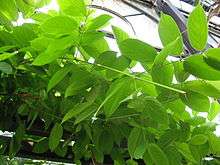Combretum indicum
Combretum indicum, also known as the Rangoon creeper[1] or Chinese honeysuckle, is a vine with red flower clusters and native to tropical Asia. It is not closely related to the true honeysuckle species Lonicera tragophylla which is also called the Chinese honeysuckle.
| Combretum indicum | |
|---|---|
| Scientific classification | |
| Kingdom: | Plantae |
| Clade: | Tracheophytes |
| Clade: | Angiosperms |
| Clade: | Eudicots |
| Clade: | Rosids |
| Order: | Myrtales |
| Family: | Combretaceae |
| Genus: | Combretum |
| Species: | C. indicum |
| Binomial name | |
| Combretum indicum (L.) DeFilipps | |
| Synonyms | |
|
Quisqualis indica L. | |

Description
The Rangoon creeper is a ligneous vine that can reach from 2.5 meters to up to 8 meters. The leaves are elliptical with an acuminate tip and a rounded base. They grow from 7 to 15 centimeters and their arrangement is opposite. The flowers are fragrant and tubular and their color varies from white to pink to red. The 30 to 35 mm long fruit is ellipsoidal and has five prominent wings. The fruit tastes like almonds when mature.
Rangoon creeper is found in thickets or secondary forests of the Philippines, India and Malaysia. It has since been cultivated and naturalized in tropical areas such as Burma, Vietnam, and Thailand.
The flowers change in colour with age and it is thought that this is a strategy to gather more pollinators. The flower is initially white and opens at dusk. This attracts hawkmoths with long tongues for pollination. On the second day it turns pink and on the third it turns red attracting day flying bees and birds. The flower also changes from a horizontal orientation to a drooping pose.[2]
Uses
The plant is used as an herbal medicine. Decoctions of the root, seed or fruit can be used as antihelmintic to expel parasitic worms or for alleviating diarrhea. Fruit decoction can also be used for gargling. The fruits are also used to combat nephritis. Leaves can be used to relieve pain caused by fever. The roots are used to treat rheumatism.
The seeds of this and related species, Quisqualis fructus and Q. chinensis, contain the chemical quisqualic acid, which is an agonist for the AMPA receptor, a kind of glutamate receptor in the brain. The chemical is linked to excitotoxicity (cell death).[3][4] The seeds from the pod are useful for treating Roundworm and Pinworm. It is toxic to the parasite and kills it in the digestive tract.
History
Dr John Ivor Murray sent a sample of the "nuts" to the Museum of Economic Botany in Edinburgh in 1861, with a note that they were "used by the Chinese for worms" and a description of the means of preparation and dosage.[5]
References
- "Combretum indicum". Germplasm Resources Information Network (GRIN). Agricultural Research Service (ARS), United States Department of Agriculture (USDA). Retrieved 8 August 2019.
- Eisikowitch, D.; Rotem, R. (1987). "Flower Orientation and Color Change in Quisqualis indica and Their Possible Role in Pollinator Partitioning". Botanical Gazette. 148 (2): 175. doi:10.1086/337645. JSTOR 2995472.
- Excitotoxic cell death and delayed rescue in human neurons derived from NT2 cells, M Munir, L Lu and P Mcgonigl, Journal of Neuroscience, Vol 15, 7847–7860
- Glutamate cytotoxicity in a neuronal cell line is blocked by membrane depolarization. T. H. Murphy, R. L. Schnaar, J. T. Coyle and A. Sastre. Brain Research Volume 460, Issue 1, 13 September 1988, Pages 155–160
- Traill, Dr William (1863). "I. Notes on Horticultural Experience at Russelconda, South India" (PDF). Transactions of the Botanical Society of Edinburgh. 7 (1–4): 109–110. doi:10.1080/03746606309467805.
External links
- QUISQUALIS INDICA Linn
- niyog-niyogan.doc
- Quisqualis indica L.
- Quisqualis indica (PIER species info)
- Madhumalati (Quisqualis indica)
- Dressler, S.; Schmidt, M. & Zizka, G. (2014). "Combretum indicum". African plants – a Photo Guide. Frankfurt/Main: Forschungsinstitut Senckenberg.
| Wikimedia Commons has media related to Combretum indicum. |